Nicole schreibt...
Lanzarote 2020 |
 |
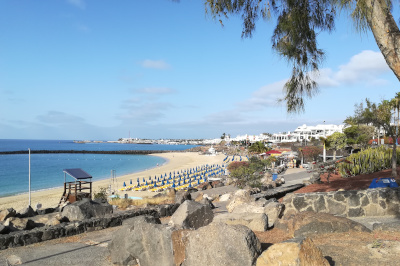 If one good thing had come out of my cruise to the Canary Islands a few years ago it was the realization that Lanzarote with its stark volcanic landscapes and picturesque white villages was surprisingly attractive. And since the rip-off excursion we had booked on the ship had not taken us inside Timanfaya National Park but only alongside it, I had always thought it would be a good place to return to. Add to this the fact that I was really rather fed up with long-distance flights, Lanzarote became the winter break of choice this year instead of destinations further afield. You'd think I had learned by now that the "islands of eternal spring" are just not warm enough for a proper beach holiday at this time of the year but at least I had packed a few warmer clothes this time.
If one good thing had come out of my cruise to the Canary Islands a few years ago it was the realization that Lanzarote with its stark volcanic landscapes and picturesque white villages was surprisingly attractive. And since the rip-off excursion we had booked on the ship had not taken us inside Timanfaya National Park but only alongside it, I had always thought it would be a good place to return to. Add to this the fact that I was really rather fed up with long-distance flights, Lanzarote became the winter break of choice this year instead of destinations further afield. You'd think I had learned by now that the "islands of eternal spring" are just not warm enough for a proper beach holiday at this time of the year but at least I had packed a few warmer clothes this time.We had decided to avoid the two biggest mass tourism centres Costa Teguise and Playa del Carmen and instead opted for Playa Blanca in the very south with the neighbouring island of Fuerteventura on the horizon. Playa Blanca consists of a lovely and rather touristy main beach (above) and the rather upmarket Rubicon Marina next door (below left), where our hotel was located. It was called Hotel Volcan and I kid you not, the main building with the reception had a conical top shaped like a volcano and the way to reception was through the replica of an ancient church that had once stood lonely on this spot. The hotel looked like a whole little village with several small buildings rather than one massive concrete bunker and the marina provided us with half a dozen proper Spanish restaurants and tapas bars, which was a welcome relief after fearing the usual mass tourism offerings of the Spanish islands with their German wursts and English breakfasts. So, overall a perfect choice of hotel and destination.
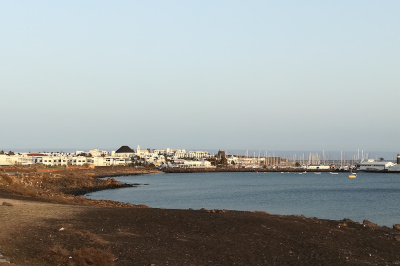
|
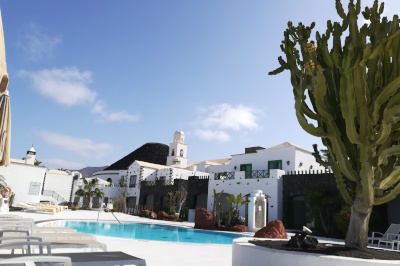 |
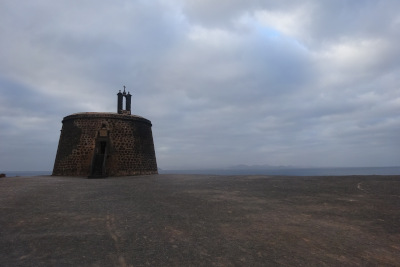
The first full day was given to doing not much at all except to hang around the pool, stuff our faces with tapas and go for a walk along the coast. Right around the corner of the hotel on the way to the lovely deserted beaches of Papagayo is the ancient Castillo de las Coloradas, plonked there in 1742 to look out for the English, French and Berberian pirates that kept haunting the Canary Islands as they were an important stop for Spanish ships transporting gold and silver home from the New World. The local government apparently has plans to transform it into a little museum, but right now it's just an inaccessible shell in a prime location (if you squint, you can see the barren hills of Fuerteventura on the horizon).
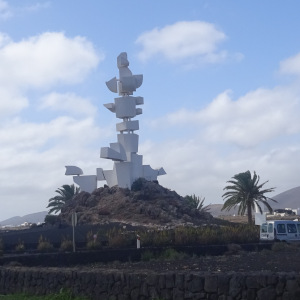 We also went to get our own wheels and next morning started a proper exploration of Lanzarote. Which basically means following the exploits of the man, who single-handedly transformed the island and protected it from the blight of mass tourism elsewhere: César Manrique.The artist and architect lived on Lanzarote from 1919 to 1992 and created some of the most attractive buildings on the island. He also campaigned long and hard to not allow buildings taller than two stories anywhere on Lanzarote and to prohibit billboards and other advertising crap along the streets.
We also went to get our own wheels and next morning started a proper exploration of Lanzarote. Which basically means following the exploits of the man, who single-handedly transformed the island and protected it from the blight of mass tourism elsewhere: César Manrique.The artist and architect lived on Lanzarote from 1919 to 1992 and created some of the most attractive buildings on the island. He also campaigned long and hard to not allow buildings taller than two stories anywhere on Lanzarote and to prohibit billboards and other advertising crap along the streets.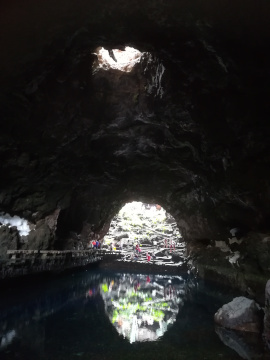 One of his first works of art was the Monumento del Campesino (left), a monument dedicated to the rural workers of the island near San Bartolomé (in what's supposedly the geographical center of Lanzarote). It was only the start though - he would go on to create unique buildings in which a fusion of nature and art stood central. One of those was our first destination, the Jameos del Agua.
It's an ancient volcanic cave with a subterranean lake which forms the worldwide unique habitat of the white albino cave crab. The natural light made good photos nearly impossible, but I think this one captures the atmosphere rather well. It's also only the beginning. When you leave the cave on the other side, you reach this incredibly beautiful garden complete with lagoon-like pool and the main event, a subterranean concert hall with supposedly amazing acoustics. While we couldn't test that out, it's not hard to believe that concerts there must be very special.
One of his first works of art was the Monumento del Campesino (left), a monument dedicated to the rural workers of the island near San Bartolomé (in what's supposedly the geographical center of Lanzarote). It was only the start though - he would go on to create unique buildings in which a fusion of nature and art stood central. One of those was our first destination, the Jameos del Agua.
It's an ancient volcanic cave with a subterranean lake which forms the worldwide unique habitat of the white albino cave crab. The natural light made good photos nearly impossible, but I think this one captures the atmosphere rather well. It's also only the beginning. When you leave the cave on the other side, you reach this incredibly beautiful garden complete with lagoon-like pool and the main event, a subterranean concert hall with supposedly amazing acoustics. While we couldn't test that out, it's not hard to believe that concerts there must be very special.
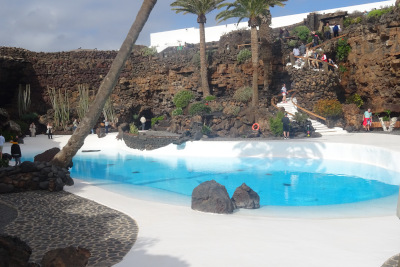
|
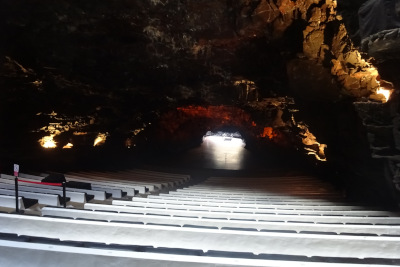 |
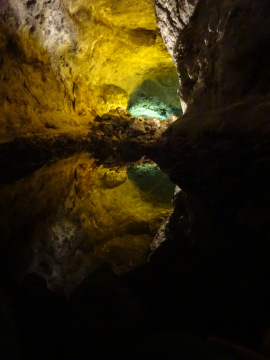
Jameos del Agua is part of a six kilometre long system of underground volcanic tubes that was created during the eruption of Monte Corona around 4000 years ago. The main entrance to the system is the Cueva de los Verdes nearby, where you can wander along a path on an hour-long guided tour, which was very impressive. Both in just how incredible mother nature's artwork is and how they managed to resist temptation to touristify it up with naff lighting or special effects. They really didn't need much for a truly mind-boggling party trick: Leading you to what looks like a deep cave... until the guide chucks a little stone in and you realize it's a perfect reflection on a perfectly still and invisible lake. From the cave we continued to the last stop for the day, the Mirador del Rio on the very northern tip of Lanzarote. Once a derelict fortification looking out over neighbouring La Graciosa, Manrique transformed it into a beautiful and somewhat futuristic view point/restaurant half-hidden inside the rocks. Here's another pic of the volcanic cave as well as the Mirador del Rio:
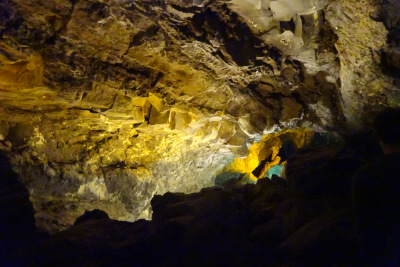
|
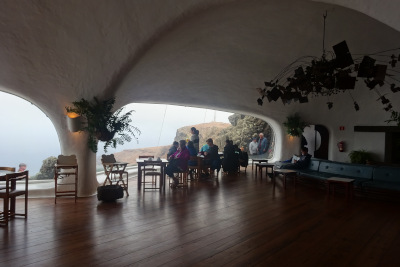 |
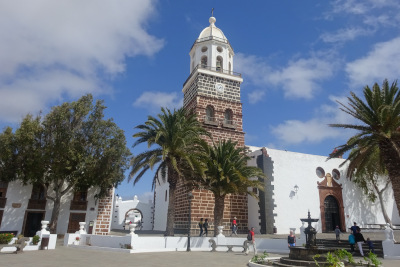
Last stop for the day was the beautiful little town of Teguise, Lanzarote's first capital, which we had briefly stopped at during that shore excursion but not really explored. There isn't really all that much to see, but the central square with the church Nuestra Señora de Guadalupe and the pretty quiet streets surrounding it are just lovely. I would have liked to visit the pirate museum in Castillo Santa Barbara, perched on a rock above the town, but sadly it was closed for renovations. So instead we found a perfect place with a roof terrace for late lunch before returning to Playa Blanca and the hotel for the rest of the day.
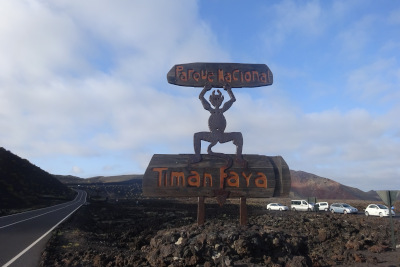 The second day was reserved for the true biggie, Timanfaya National Park. As it turns into a tourist circus fairly quickly it's best to show up right at 9am when the gates open and good thing we did. They don't allow tourists to explore the "Ruta de los Volcanos" on their own (for very good reasons) and instead pack them onto coaches with commentary and a rather bizarre classical soundtrack. As we arrived early, we could board the very first coach and were off pretty much immediately, while the queues later must be horrible.
So here's a fun fact: I had thought that the breathtakingly stark volcanic landscapes of Lanzarote, that have doubled as Mars and other planets in sci-fi movies, were all the result of volcanic activity millenia ago but in fact the Timanfaya's last big eruptions date from 1730 to 1736 when he covered a big part of the island's south west in rubble and buried whole villages underneath. He's still rumbling on and they do a neat show of barbecueing meat and potatoes over an "open fire" and chuck water down a tube, that quickly comes back as an impressive geysir. I couldn't really take good pictures from the coach window, but the landscape is one of the most incredible sights I've ever seen and worth a trip to Lanzarote alone for.
The second day was reserved for the true biggie, Timanfaya National Park. As it turns into a tourist circus fairly quickly it's best to show up right at 9am when the gates open and good thing we did. They don't allow tourists to explore the "Ruta de los Volcanos" on their own (for very good reasons) and instead pack them onto coaches with commentary and a rather bizarre classical soundtrack. As we arrived early, we could board the very first coach and were off pretty much immediately, while the queues later must be horrible.
So here's a fun fact: I had thought that the breathtakingly stark volcanic landscapes of Lanzarote, that have doubled as Mars and other planets in sci-fi movies, were all the result of volcanic activity millenia ago but in fact the Timanfaya's last big eruptions date from 1730 to 1736 when he covered a big part of the island's south west in rubble and buried whole villages underneath. He's still rumbling on and they do a neat show of barbecueing meat and potatoes over an "open fire" and chuck water down a tube, that quickly comes back as an impressive geysir. I couldn't really take good pictures from the coach window, but the landscape is one of the most incredible sights I've ever seen and worth a trip to Lanzarote alone for.
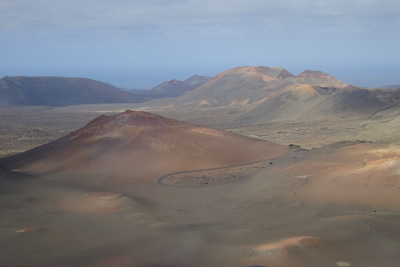
|
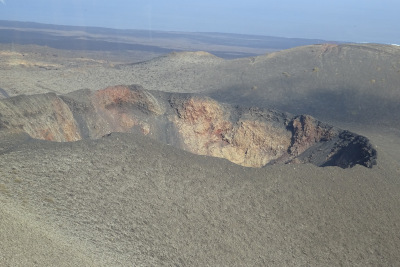 |
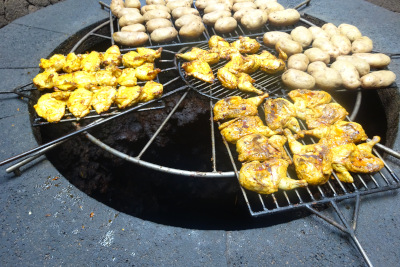
|
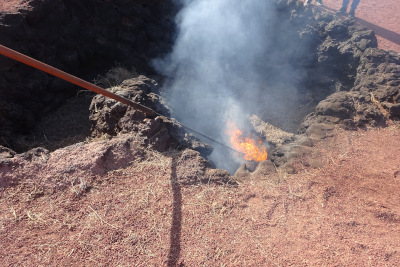 |
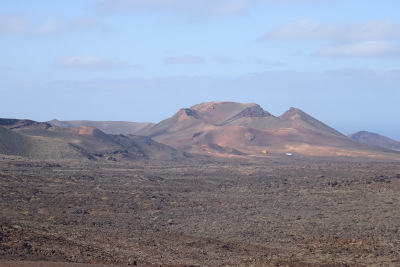 The two colorful dots in the distance are an official coach and a tour group coach in the vast barren landscape of the national park.
From here we continued to the pretty little village of El Golfo with its unique coast line. It, too, was created during the Timanfaya's eruption in 18th century when the lava flowed into the sea, where it cooled off quickly and turned to stone. The village itself is nestled in what's left of the crater of another ancient volcano, the Montaña de Golfo with its unique little lake, the Charco de los Clicos. It's not as luridly green as it used to be since they've cleaned it (and the algae inside) up, but it's still quite a sight to see.
The two colorful dots in the distance are an official coach and a tour group coach in the vast barren landscape of the national park.
From here we continued to the pretty little village of El Golfo with its unique coast line. It, too, was created during the Timanfaya's eruption in 18th century when the lava flowed into the sea, where it cooled off quickly and turned to stone. The village itself is nestled in what's left of the crater of another ancient volcano, the Montaña de Golfo with its unique little lake, the Charco de los Clicos. It's not as luridly green as it used to be since they've cleaned it (and the algae inside) up, but it's still quite a sight to see.
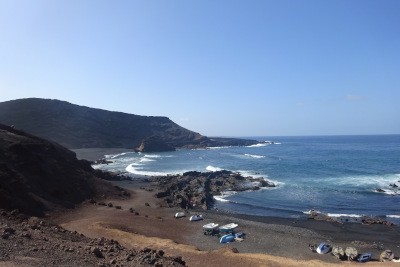
|
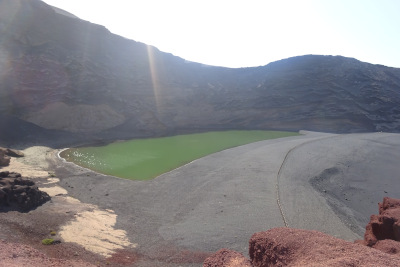 |
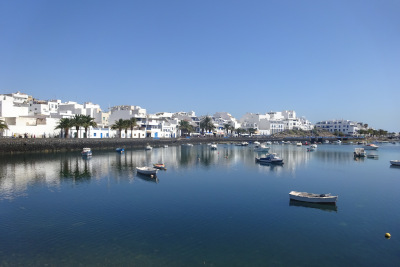 We ended our second day in the little capital Arrecife, which we had only half-seen on that cruise stop, although it was enough to remember the picturesque lagoon Charco de San Ginés with its fishing boats bobbing under the sun and lovely little cafés. We had lunch there and strolled along the small shopping street before it was time to retrieve the car and return to Playa Blanca to drop off the car.
The remaining one and a half days were spent doing not much at all by the hotel pool(s), wandering around the Marina, making friends with a local cat called Sylvia and enjoying delicious local food such as beef in a wine sauce made from Lanzarote red wine and the very sweet and delightful Bienmesabe dessert with almonds.
We ended our second day in the little capital Arrecife, which we had only half-seen on that cruise stop, although it was enough to remember the picturesque lagoon Charco de San Ginés with its fishing boats bobbing under the sun and lovely little cafés. We had lunch there and strolled along the small shopping street before it was time to retrieve the car and return to Playa Blanca to drop off the car.
The remaining one and a half days were spent doing not much at all by the hotel pool(s), wandering around the Marina, making friends with a local cat called Sylvia and enjoying delicious local food such as beef in a wine sauce made from Lanzarote red wine and the very sweet and delightful Bienmesabe dessert with almonds.
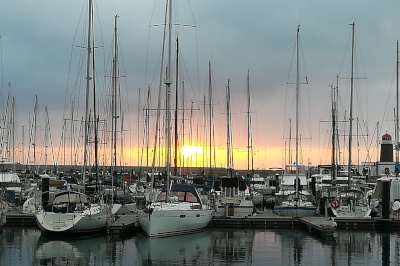
Overall I'm really glad I have finally seen Lanzarote properly and if you love spectacular nature and/or unique art, the island of volcanos and of César Manrique is definitely a good idea. I may also want to see Gran Canaria properly some day, but overall I hope I've finally learned that the Canary Islands just don't hack it as a winter beach break, so who knows where you may find me next winter... We know which part of the Earth is forever calling :)
Copyright © All Rights Reserved